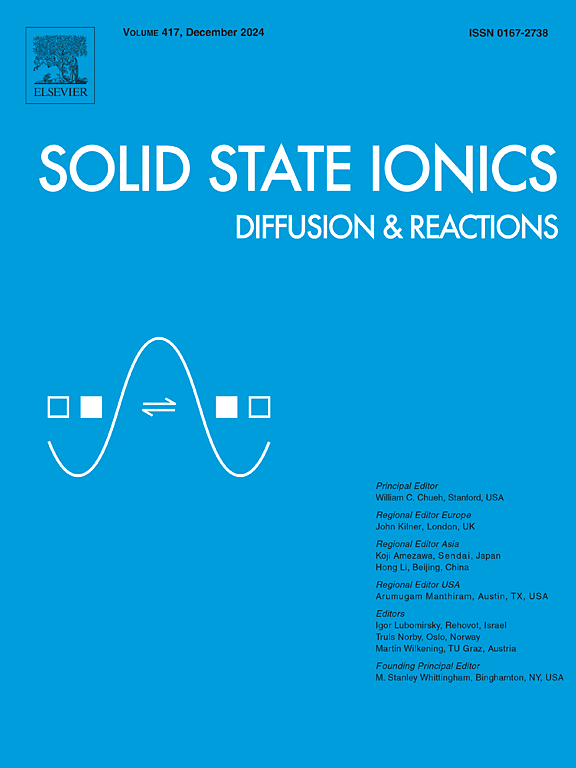Rational molecular design of partly fluorinated fuel cell membranes with high proton conductivity under low-humidity conditions
IF 3
4区 材料科学
Q3 CHEMISTRY, PHYSICAL
引用次数: 0
Abstract
Research on proton exchange membranes (PEMs) is closely tied to the development of PEM fuel cells, and the need to overcome the shortcomings of perfluorosulfonic acid PEMs. One of the key challenges is to devise efficient molecular designs towards PEMs with sufficient durability and proton conductivity under reduced humidity. Here, we report on a series of partly fluorinated PEMs based on high-molecular weight poly(arylene tetrafluorophenylsulfonic acid)s, synthesized in polyhydroxyalkylations of perfluoroacetophenone and balanced mixtures of bipenyl and p-terphenyl. Sulfonic acid groups were then introduced on the pendant pentafluorophenyl groups of the resulting polymers through an efficient thiolation-oxidation procedure. The fluorine content of these aromatic polymers was approximately 1/6 of the Nafion® benchmark. Foldable flexible PEMs were produced by tape-casting and showed thermal stability up to 260 °C, as well as excellent radical resistance. The proton conductivity increased with the acid content, and the PEM based on merely biphenyl reached 250 mS cm−1 at 120 °C under fully humidified conditions, exceeding Nafion® NR212 by a factor 1.6. Under 30 % relative humidity at 80 °C, the same PEM achieved an outstanding 50 mS cm−1, surpassing Nafion® by a factor 2.3. With a considerably higher acidity and lower ion exchange capacity than typical sulfonated hydrocarbon polyphenylene PEMs such as Pemion®, and significantly lower fluorine content and higher conductivity than Nafion®, the characteristics of the present PEMs may offer distinct advantages for fuel cells operating under reduced humidity.

低湿度条件下高质子导电性部分氟化燃料电池膜的合理分子设计
质子交换膜的研究与质子交换膜燃料电池的发展密切相关,需要克服全氟磺酸质子交换膜的缺点。关键的挑战之一是设计高效的分子设计,使其在低湿度条件下具有足够的耐用性和质子导电性。在这里,我们报道了一系列基于高分子量聚芳烯四氟苯磺酸的部分氟化PEMs,这些PEMs是在全氟苯酮的多羟基烷基化反应和对苯的平衡混合物中合成的。然后通过有效的硫代氧化程序将磺酸基团引入到所得到的聚合物的垂坠的五氟苯基上。这些芳香族聚合物的氟含量约为Nafion®基准的1/6。可折叠柔性PEMs采用带铸法制备,具有高达260°C的热稳定性和优异的抗自由基性。质子电导率随着酸含量的增加而增加,在完全加湿的条件下,仅基于联苯的PEM在120°C下达到250 mS cm - 1,比Nafion®NR212高出1.6倍。在80°C的30%相对湿度下,相同的PEM实现了出色的50 mS cm - 1,超过了Nafion®2.3倍。与典型的磺化烃聚苯pem(如Pemion®)相比,pemm具有更高的酸度和更低的离子交换容量,并且比Nafion®具有更低的氟含量和更高的电导率,因此,当前pemm的特性可能为在低湿度条件下运行的燃料电池提供明显的优势。
本文章由计算机程序翻译,如有差异,请以英文原文为准。
求助全文
约1分钟内获得全文
求助全文
来源期刊

Solid State Ionics
物理-物理:凝聚态物理
CiteScore
6.10
自引率
3.10%
发文量
152
审稿时长
58 days
期刊介绍:
This interdisciplinary journal is devoted to the physics, chemistry and materials science of diffusion, mass transport, and reactivity of solids. The major part of each issue is devoted to articles on:
(i) physics and chemistry of defects in solids;
(ii) reactions in and on solids, e.g. intercalation, corrosion, oxidation, sintering;
(iii) ion transport measurements, mechanisms and theory;
(iv) solid state electrochemistry;
(v) ionically-electronically mixed conducting solids.
Related technological applications are also included, provided their characteristics are interpreted in terms of the basic solid state properties.
Review papers and relevant symposium proceedings are welcome.
 求助内容:
求助内容: 应助结果提醒方式:
应助结果提醒方式:


